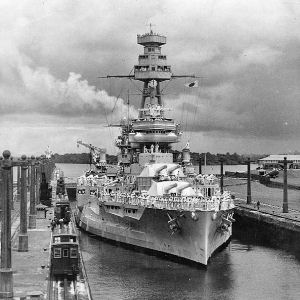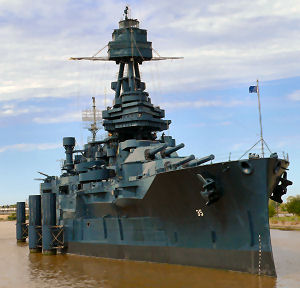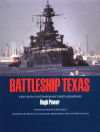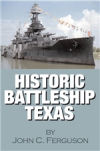
HOME
INTRO
SYMBOLS
ALMANAC
ECONOMY
GEOGRAPHY
STATE MAPS
PEOPLE
FORUM
NEWS
COOL SCHOOLS
STATE QUIZ
STATE LINKS
BOOK STORE
MARKETPLACE
NETSTATE.STORE
NETSTATE.MALL
GUESTBOOK
CONTACT US


Tweet
Double click any word in document for definition.
Texas State Ship

Texas State Ship: Battleship Texas
Gatun Locks, Panama Canal (1937)
Photograph: Naval Historical Center
To date, four ships U.S. Navy ships have been named to honor the State of Texas.
- Commissioned in 1892, the USS Texas ("Old Hoodoo") was the U.S. Navy's first battleship. Old Hoodoo was renamed "San Marcos" to allow a new battleship, BB-35, to take her name. Used as target practice, she was sunk in the Atlantic Ocean on March 11, 1911, seven miles south-southwest of Tangier, Virginia.
- This is the official state ship of the State of Texas. Commissioned in 1914, the USS Texas, a New York class battleship, is the vessel recognized by Senate Concurrent Resolution No. 101.
- Commissioned in 1977, the nuclear powered guided missile destroyer/cruiser USS Texas became the third vessel to be named for the state. After over fifteen years of service, she was decommissioned on July 16, 1993 and is currently held at Puget Sound Naval Shipyard, Bremerton, Washington. [ Naval Vessel Register ]
- Commissioned in 2006, a fast attack nuclear submarine USS Texas became the fourth vessel to honor the state of Texas. As of August, 2017, the submarine is still in service. [ Naval Vessel Register ]
As noted above, House Concurrent Resolution No. 101 refers to the second U.S. Navy vessel named to honor the State of Texas, a battleship (BB-35) commissioned on March 12, 1914.
BB-35 served for over 34 years, participating in World War I and in World War II. She is one of only eight remaining U.S. Navy battleships and the country's oldest surviving battleship.
Texas gets a battleship
View Larger Map
We'll pick up the story of the battleship Texas (BB-35) after her service in two world wars.
Retired and scheduled for target practice, a group of Texans rose up in protest.
A plan was devised where the BB-35 would be turned over to the State of Texas and be placed under the care of the Battleship Texas Commission, a group of Houston businessmen.
BB-35 was towed from Baltimore, Maryland to a berth at San Jacinto State Park off the Houston Ship Channel, arriving on April 21, 1948. The USS Texas was decommissioned on that same date.
In the long term, BB-35 did not fare well. Initially afloat, the battleship had settled into the mud and muck of the Buffalo Bayou where she was birthed. Without the care she would have received as a commissioned vessel, dry dock every six to eight years, BB-35 rusted and leaked and rusted some more.
In 1983, the severely deteriorating "Texas" was placed in the care of the Texas Parks and Wildlife Department.
Through a combination of U.S. Navy funds, state funds, private donations, and school children who donated their pennies, the Texas was moved to dry-dock at Todd Shipyard & Dry-dock Co. in Galveston. Texas remained in dry-dock from December 1988 to February 1990. After replacing 235,000 pounds of steel hull, replacement of the ship's wooden deck, and 9,200 gallons of paint, the Texas was moved back to San Jacinto State Park.
On March 27, 1995, the Texas State Senate suspended its rules and immediately approved of Jerry Patterson's Senate Concurrent Resolution No. 101.
S.C.R. No. 101
SENATE CONCURRENT RESOLUTION
WHEREAS, The State of Texas has traditionally recognized a variety of official state symbols that embody the proud spirit and unique heritage of our state; and
WHEREAS, The bluebonnet, the pecan tree, and the mockingbird are examples of some natural specimens that serve to symbolize the great diversity of the Texas landscape, while the state dish, chili, fittingly represents another aspect of our shared culture as Texans; and
WHEREAS, In keeping with this custom, the designation of the battleship Texas as the official State Ship of Texas will provide suitable recognition for this historic symbol of Texas' indomitable spirit; and
WHEREAS, Commissioned in the Norfolk Navy Yard on March 12, 1914, the U.S.S. Texas served in the Atlantic theater during World War I; later, from 1925 to 1926, the Texas was modernized and served as a fleet flagship for the United States Navy; and
WHEREAS, In 1939, this exceptional vessel was chosen as the flagship of the Atlantic Training Squadron and one year later was designated as the flagship for the commander of the Atlantic Fleet, Admiral Ernest J. King; and
WHEREAS, During World War II, the Texas served her country with great distinction, transporting troops to Europe, Africa, and the Panama Canal Zone while negotiating some of the most dangerous waters of the war; this remarkable ship was unique throughout the world in that it participated in five major Allied invasions in three separate theaters of combat: North Africa, Southern France, Northern France, Okinawa, and Iwo Jima; and
WHEREAS, Nicknamed "The Mighty T," the Texas is perhaps best known as the command ship for the bombardment of Omaha Beach, on whose historic sands American soldiers displayed unflinching bravery in the face of withering enemy fire to begin the long awaited liberation of France; and
WHEREAS, During her entire record of distinguished service to the United States, the Texas experienced only one fatality and 14 wounded while off the coast of Cherbourg, France; following her retirement from service, "The Mighty T" was given to the State of Texas, and today she is moored near the San Jacinto Battleground State Historical Park; and
WHEREAS, The U.S.S. Texas performed a vital role in the success of many critical missions during peacetime and both world wars, epitomizing the strength, resolve, and gritty determination of her namesake state; this year, as we commemorate the 50th anniversary of the end of World War II, it is indeed appropriate that this mighty vessel be given special legislative recognition as an official symbol of the Lone Star State; now, therefore, be it
RESOLVED, That the 74th Legislature of the State of Texas hereby designate the battleship Texas as the official State Ship of Texas.
The battleship "Texas" became the official state ship of Texas when Governor George W. Bush signed Senate Concurrent Resolution No. 101 on June 16, 1995.
Ten years later, the Elissa was named the official tall ship of the State of Texas.
Texas Law

Texas State Ship: Battleship Texas
USS Texas in San Jacinto State Park, October 2006.
The battleship U.S.S. Texas was named the official ship of the State of Texas by House Concurrent Resolution and is not, therefore, listed in the Texas Statutes.
Only a few of Texas' myriad symbols were actually adopted by an act of the legislature and written into the Texas Statutes.
Sources...
"USN Ships--USS Texas (BB-35)." Naval History and Heritage Command. Naval History and Heritage Command, 17 Jun 2007. Web. 17 Apr 2012.
Patterson, Jerry. "Senate Concurrent Resolution No. 101." Legislative Reference Library of Texas. The State of Texas, 1995. Web. 17 Apr 2012.
"USS Texas BB35." Battleship Texas Foundation. Battleship Texas Foundation, n.d. Web. 17 Apr 2012.
"History." Battleship TEXAS State Historic Site. Texas Parks and Wildlife Department, n.d. Web. Apr 2012.
"Ship's History." USS Texas BB35. First TEXAS Volunteers' Website, Jul 2009. Web. 17 Apr 2012.
Shearer, Benjamin F. and Barbara S. State Names, Seals, Flags and Symbols: A Historical Guide Third Edition, Revised and Expanded. Westport, Conn: Greenwood Press, 3 Sub edition, 2001.
Additional Information
Battleship TEXAS State Historic Site: Texas Parks and Wildlife Department.
USN Ships--USS Texas (BB-35): Department of the Navy: Naval History and Heritage Command.
USS TEXAS (BB-35): Historic Naval Ships Association.
Battleship TEXAS: First TEXAS Volunteers' website.
U.S.S. Texas: Official website of The Battleship Texas Foundation.
State watercraft: Complete list of official state watercraft from NETSTATE.COM
More symbols & emblems: Complete list of official Texas state symbols from NETSTATE.COM.

Battleship Texas, by Hugh Power. 166 pages. Publisher: Texas A&M University Press; 1St Edition edition (December 1, 1992)
Battleship Texas, visited by thousands of tourists each year at its berth at San Jacinto, is the lone survivor of the first generation of dreadnoughts, the world's most complex and dominating weapon of the early twentieth century. The ship, the only intact vessel of any nation to have survived both world wars, houses the largest surviving reciprocating engines. When the ship was commissioned in 1914, its class of ship was the most powerful in the world—the most complex product of an industrial nation just beginning to become a force in global events.

Historic Battleship Texas: The Last Dreadnought, by John C. Ferguson, Director of the San Jacinto Battleground State Historic Site. 192 pages. Publisher: State House/McWhiney Foundation Press (August 27, 2007)
The battleship Texas was for a time the most powerful weapon on earth. When it was commissioned in 1914, the 14-inch guns were the largest in the world. This technological marvel of the time served with the British Grand Fleet in World War I and was the flagship of the entire U.S. Navy between the two World Wars. During the Second World War, an older Texas, past its prime, supported amphibious invasions in North Africa, Normandy, Southern France, Iwo Jima, and Okinawa. The ship and her crew were preparing for the invasion of Japan when the war ended and the Texas came home.
No longer needed to defend her country, the Texas was saved from the scrap yard to become our nation's first historic ship museum in 1948. Now lying peacefully in her berth at the San Jacinto State Park near Houston, the battleship Texas is still serving her country—teaching instead of fighting.
The Texas is the only battleship remaining in the world today that served in World War I and the only ship remaining of any type that served in both World Wars. This is the story of the battleship Texas and the brave men who walked its decks.

